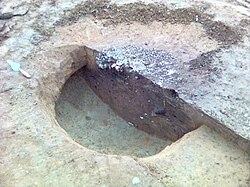Cut (archaeology)

When someone says "cut" in archaeology, they're talking about something that people did to the ground a long, long time ago. Imagine you have a big, flat sandcastle that you want to build a tunnel through. To make the tunnel, you would need to dig out some of the sand and leave a space for you to walk through. That's basically what people in the past did to the ground, except they used tools like shovels and pickaxes instead of just their hands.
Sometimes, instead of digging down into the ground, people would dig sideways to create a ditch or trench. This could be for all kinds of reasons - maybe they needed to protect their village from enemies, or maybe they were building a canal to bring water to their crops. Whatever the reason, these ditches or trenches are also "cuts" in archaeology.
When archaeologists find a cut, it can tell them a lot about what people were doing in that spot a long time ago. They might be able to tell what the cut was used for and even make guesses about who did the cutting. Finding cuts can be really exciting for archaeologists, because it means they're getting a glimpse into what life was like for people who lived hundreds or thousands of years ago.
Sometimes, instead of digging down into the ground, people would dig sideways to create a ditch or trench. This could be for all kinds of reasons - maybe they needed to protect their village from enemies, or maybe they were building a canal to bring water to their crops. Whatever the reason, these ditches or trenches are also "cuts" in archaeology.
When archaeologists find a cut, it can tell them a lot about what people were doing in that spot a long time ago. They might be able to tell what the cut was used for and even make guesses about who did the cutting. Finding cuts can be really exciting for archaeologists, because it means they're getting a glimpse into what life was like for people who lived hundreds or thousands of years ago.
Related topics others have asked about:
